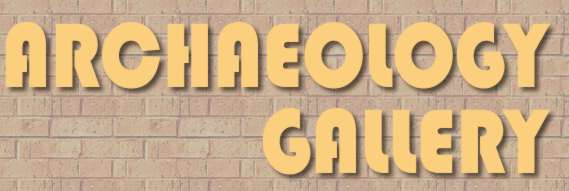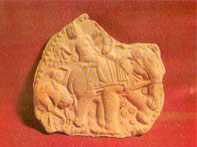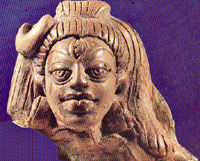
|
Besides sculptures and terracottas, the Archaeological Section of Bharat Kala Bhavan has a rich collection of some other antiquarian remains viz., pre-historic stone and copper tools, ancient potteries and pot-sherds, clay seals and sealings, ancient beads both in stone and clay and copper-plate inscriptions. The Archaeological Section possesses nearly two hundred thirty five stone tools related to Palaeolithic, Mesolithic and Neolithic cultures. These are mostly acquired through periodic explorations from the pre- historic sites. These tools include hand axes, scrappers, cleavers, chopper, core and flake tools. The rnicroliths include rnicroblades, blades, side scrapper, knife, borer, awl, burin, etc. The metal tools of Chalcolithic period are only in small quantity
in this collection. There are seven copper celts, six out of which
were acquired from the Itawa village in the district of Varanasi.
The collection also includes broken arrow-head from Kausambi, one
celt, one harpoon and two anthropomorphic figures from Bisauli in
the district of Badaun (displayed in the gallery). There are nearly 1700 seals and sealings mostly made of clay. These hail from different sites in northern India from T axila to Bihar and depict different Hindu and Buddhist deities along with legends. Of these, mention may be made of certain sealings with the Saiva symbols such as Trisula, Parasu, Nandi with legends such as Avimuktesvara, Pitakesvara, Yogesvara, Bhringesvara, etc. Varanasi sealings include Garuda, Chakra, Sankha, etc. Sealings showing goddess Durga, Abhiseka Lakshmi are also there in this collection. Buddhist sealing depict deities like Buddha, Bodhlsattva (Chmtamamchakra Lokesvara, Maitreya, Manjusri etc.), goddess Tara, stupas ~ and symbols like wheel flanked by deer with legends. These were issued by kings, courtiers, traders, trade guilds, teaching institutions and monasteries. The Section has a small but historically important copper plate incriptions. The total number of such , inscribed plates is eleven. These belong to the mediaeval ~ period and were issued by the kings of Pala, Gahadvala \ i and Chandela dynasties. These are in the form of land lgrants. Of these, mention may be made of a single copper I plate of early Pala king Rajyapala, and the inscription of Govinda Chandradeva Gahadvala of V .S. 1195 and the inscription of king Madan Verma of Chandela dynasty dated V .S. 1192. These inscriptions are mostly written in Sanskrit language but there is one inscription of Maharajadhiraja Sriraja Baj Bahadur Chandradeva which is found to be written in Kaithi script. The art ofterracottas has been of great significance for reconstruction of cultural history. Due to its malleable nature and easy availability this medium of expressioning art became extremely popular throughout the country . The earliest specimens hailed from the pre-Indus and Indus sites followed by the cult of mother goddesses which are known as archaic or ageless due to their hoary antiquity and their subsequent continuity. From the Indus to the Pre Mauryan period the terracottas were hand modelled with applique ornamental technique and evinced abundance of female figures. In the Post Indus terracottas the face of the figure is either animal or bird. These have been interpreted as mother goodesses probably following the Vedic traditions of Aditi, Mahimata, Sinivali etc. As the visitor enters the Gallery to his right he views some fabulous animals and female figurines with fan shaped head dress and separately fixed ornaments. The figure with large stomach must have served as rattle. The second showcase presents the terracottas of the Mauryan period between 4th and 2nd century B.C. The animal figures also became popular with applique treatment being continued. One horse and another elephant bear the stamped or punch marked circles which was a peculiar characteristic of the age. The black polish on the grey surface is often noticed. The female bust marks a stage of development when the head was pressed out of mould and the body remained hand modelled. The male head bearing smiling expression was recovered probabely from Patna. The third showcase is notewonhy for another stage of development of terracotta an when the entire figure was produced through mould and sometimes the double mould was also used to shape a figure in the round. Kausambi in Allahabad district has been the mine of early Indian terracottas. With the introduction of moulds, the growing need of society for terracottas was fulfilled. The subject matter became varied with the inception of new divinities and secular themes. The visitor sees an interesting toycan illustrating a picnic pany.
The other plaque shows a man with deer followed by the scene representing the elopment of Vasavadatta by Udayana. Another plaque representing Lakshmi (goddess of prosperity and abundance) majestically standing on a high lotus seat under a large umbrella. She is flanked by two flywhisk bearing attendants who also stand on stalked lotus seats. The hole on the top of some of these plaques testifies that these were used as wall hanging in houses or place of worship. The colour of Sunga terracottas is generally dul red and buff, but in some regions as at Mathura, tradition of grey coloured terracottas continued. One of such specimens is on view and it shows a large size mother goddess with beautiful hairdo decorated with weapon type ornamental motifs and a number of ornaments . In the northern India the art of terracottas suffered to some extent as the attention was focussed on stone which was used for architecture and sculpture. Thc figures produced in this period (lst-3rd century A.D.) are rather coarse and crude and look somewhat primitive and folkish The expression, however, is quite bold. Thc showcase shows male and female heads, a dwarf probably Yaksha and the head of Siva with third eye Luckily the Museum houses a few specimens of terracotta art from Kashmir region and these bear Gandhara impact. A young roundish male head is followed by an interesting female head with locks of hair falling on thc temples. The hair is fastened with the drum shaped bead The figure is coated with green glaze which is a rare feature.
The next showcase shows two forceful headless busts from Kausambi -one representing Chamunda with skeleton and with suspended breasts and Darpana Gauri in which case Parvati holds mirror in one of her hands. On the floor is seen a storage jar hailing from Rajghat (Varanasi) belonging to post-Gupta period c.7th-8th century A.D. On the adjacent wall the continuity of terracotta art is marked by a few specimens inside the showcase depicting Krishna Lila and Mahisasuramardini from Bengal and belonging to 18th-19th century A.D. Two greyish terracottas from Nepal of the same period, representing Ganga on crocodile and Visvarupa Vishnu are also on view. |

